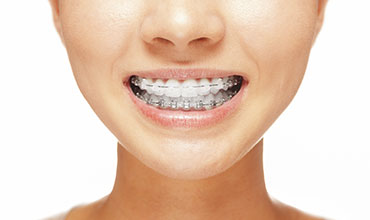
Braces aren't just for teenagers – it’s never too late to improve your dental health and beautify your smile. About 1 million Americans over the age of 18 wear braces. Reynolds Dentistry can help you determine if orthodontic treatment is the right option for you. Reynolds Dentistry may even be able to treat your orthodontic problems..
Some adults never received orthodontic treatment as children to correct problems such as crooked or crowded teeth, overbites and underbites, incorrect jaw position or jaw joint disorders. Left untreated, these problems may result in tooth decay, gum disease, headaches and earaches, as well as speaking, biting or chewing problems.
Braces can provide adults the same benefits children receive. However, treatment may take longer than it does for children. The average adult wears braces for 18 months to three years. As with children, adults may need to wear a retainer to maintain the results of treatment after braces are removed.
The cost of braces depends on the type you select. On average, metal braces cost $5,000 to $6,000. Keep in mind that your out-of-pocket costs will likely be higher if you choose non-metal braces. Check your Evidence of Coverage, Summary Plan Description or Group Dental Service Contract to see if your dental plan covers orthodontic treatment for adults. You should also ask Reynolds Dentistry to submit a pre-treatment estimate (also called a predetermination) to your dental plan so you can find out in advance what your out-of-pocket costs will be.
Consult with Reynolds Dentistry and ask for an evaluation. Depending on the complexity of your case, Reynolds Dentistry may choose to treat you or refer you to an orthodontist – a dentist who specializes in the diagnosis, prevention and treatment of dental and facial irregularities.
The initial consultation provides an opportunity to ask questions about orthodontic treatment:
Braces are custom-made appliances that use applied pressure to straighten your teeth and correct your bite. While some practitioners still favor metal braces as the most reliable, new materials and other technological advances have made smaller, less noticeable braces available. Instead of metal, you may be able to wear clear or tooth-colored ceramic braces or removable invisible aligners.
You probably will experience some discomfort or difficulty speaking or eating when you first receive your braces. While wearing braces, keep your teeth and brackets clean. If you wear cemented, non-removable braces, food and plaque can get trapped between the teeth and gums. To reduce your risk of cavities, follow a regimen of brushing, flossing and rinsing, and reduce your consumption of sweets and carbohydrates. Good oral hygiene may also prevent decalcification (white spots) on teeth and tooth decay.
It's a good idea to skip foods that can damage or dislodge braces. Avoid hard foods such as candy, raw carrots, corn on the cob, pretzels, nuts, popcorn and crushed ice. Other foods to avoid include sticky foods such as caramel, taffy and gum. These foods can get stuck between teeth and gums or bend wires and knock bands or brackets loose. If this results in damage to braces, treatment may be extended.